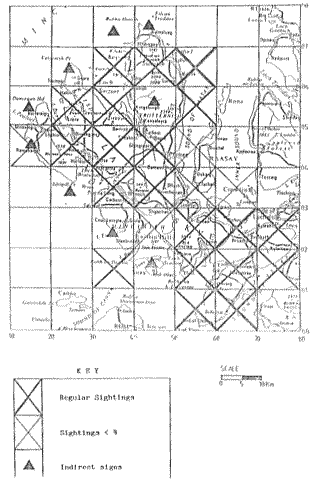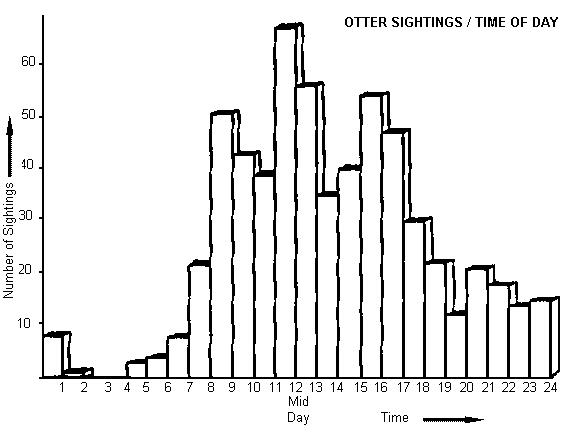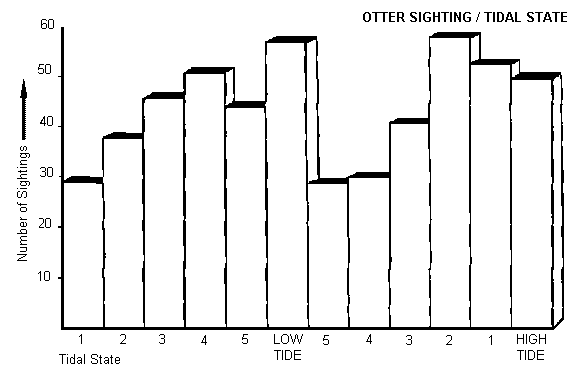 |
Last Update:
Friday November 23, 2018
|
| [Home] |
|
Volume 5 Pages 1 - 83 (March 1990) Citation: Yoxon, G. and Yoxon, P. (1990) Otter survey of the Isle of Skye, Scotland. IUCN Otter Spec. Group Bull. 5: 70 - 75 Otter survey of the Isle of Skye, Scotland (Lutra lutra) Grace and Paul Yoxon Skye Environmental Centre, Harapool, Broadford, Isle of Skye, IV49 9AQ, Scotland
To date a lot of research on otter distribution has taken place in areas where otter populations are under threat. It was particularly disturbing to read in IUCN bulletin No 4 of the probable extinction of the Eurasian otter from the Netherlands; it was only three years ago that a delegation from that country visited Skye in order to examine our habitats with a hope of saving their last remaining otter populations. It is important in conservation to have data readily available a long time before any threat to a population occurs. The otter survey of Skye is being conducted with two very important alms: firstly, to develop a method of systematically recording otter sightings and secondly to make the public more aware and appreciative of the otter and its vital place in the ecological system. This awareness and understanding will play a large part in governing its future survival. The Island of Skye, off the north-west coast of Scotland, is ideally suited for the purposes of this survey. Skye is a manageable size for such a project and many of the developments effecting the whole of the Highlands are occurring here. These include the widespread expansion of Fish Farming, Tourism, Forestry and the related infrastructure. The island does have a healthy population of otters and in terms of the state of the Eurasian otter in the rest of Europe it is true to say that the island is one of its last remaining strongholds. The results after two years of the survey provide detailed information on the distribution, and will act as a framework for future monitoring of the condition of the otter on Skye. By using direct sightings and observations it will also give much needed information on the habits and behaviour of the animal. To date records of 802 sightings have been received over the two year period. METHOD The use of spraint to monitor otter populations has recently been the subject of much debate but the Skye survey is based on actual otter sightings. An added advantage of sightings records is that it is possible to study breeding and general activity and family groups and so build up a far more accurate picture of otters, their behaviour, distribution and population. Additional spraint analysis work was undertaken for one local otter. This was done on a weekly basis for a period of twelve months and has shone some light on the seasonal feeding habits of Skye otters. RESULTS For recording purposes the island was divided into ten kilometre grid squares of the National Grid System, giving a total of 33 survey squares. In 20 of the grid squares, otters were observed on a regular basis and in 4 squares less than four sightings were recorded. In 9 of the squares no otter sightings were recorded at all and these were therefore surveyed in detail using indirect signs, mostly sprainting points. All these other squares showed signs of otters. The areas concerned are very remote and rarely visited by humans; it la therefore more likely that the lack of sightings was related to this fact rather than that are less otters or that they are more shy here.
Most of the data comes from coastal otter sightings which represents some 97% of the data. In some areas of the island a distinct distribution of otter home ranges has been established, and these can be seen to occupy a coastal strip from 1.5-2.0 km long. These otters do not seem to roam a great deal probably due to the abundance of food in the coastal zone habitat. The data and observations seem to contradict many of the long-established "facts" about otters: for example that they are shy, elusive, nocturnal and solitary animals which may be observed early in the morning, late at night and on an ebbing tide. In fact there is a distinct lack of correlation with regard to sightings of otters and the time of day or tide state, as shown in the accompanying graphs.
Spraint analysis has revealed a definite variation in diet according to season. For example, frogs and toads formed a large part of the diet early and late in the year but were not so common at other times. This is probably related to the activities of the amphibians themselves as they are easier to catch around the time of their hibernation. Various fish also had peaks at different times of the year which was often related to their breeding season. For example, sand eels are generally more offshore but come further in to breed in the autumn, and this is when they appear in the spraint. However, it must be recognised that this spraint analysis only shows the seasonal variation in diet of this particular otter. As Watson (1978) points out it is likely that individual animals will have their own dietary preferences. It has bean observed generally that in other spraints the animals seem to prefer shellfish in summer and fish in winter. This again would appear to be related to activity of the prey, in that shellfish move into deeper water and cracks in the rocks in winter and are therefore harder to find, so the otters resort to fish, which do however require more energy to catch. Therefore in summer it is easier to take shellfish which are readily available. However, the otter under study would seem to show a personal preference for fish generally for the whole year rather than turning to shellfish in the summer. Furthermore personal observations have shown that individual otters can show a distinct preference for poultry including hens and ducks as large as Muscovy ducks. They have also been seen stalking geese, but to date these have remained safe! BREEDING SEASON There does seem to be some evidence for a definite breeding season on the island and weather and availability of food would seem to govern this. All the detailed data on mating comes from areas on Skye where regular information, often on an almost daily basis, is being collected. Only four tines were otters actually observed mating, although on another two occasions they were seen courting, which involved rapid racing and playing. On one occasion the otters drew attention to themselves during this courting activity by the noise they made calling out. The observations of mating and courting occurred during the months of February through to May. On each occasion the pairs were seen to remain together for a period of half an hour to an hour with mating following a period of vigorous chasing, swimming and playing. The first sightings of mother and cubs were in the summer months from June to July. If we allow for the gestation period and the time they remain within the holt all such sightings would appear to correspond with the mating season in February to May. The mean litter size was 2.3 cubs and on average 3 weeks after leaving the holt the cubs are fully weaned and can be observed independently of the mother. However their relationship can last into December and January and on some occasions the previous years' cubsa have been seen with the mother and her present cubs. This would without doubt indicate a strong social bond between the family group, particularly as the male is sometimes also seen in the group. In some areas the male seems to be faithful to the bitch and the home range. DISCUSSION The island of Skye does hold a healthy population of mostly coastal otters. However there is a continual increase in pressure on the island with a four-fold increase in fish farming, increased use of the sea-bed by crustacean fishing, widening of roads, and increased tourist pressure. If we look at otter deaths recorded to date we see that road mortalities among otters is the most alarming cause of non-natural mortality. Obviously as developments increase and roads are widened with increased traffic these deaths will rise. If the population is to remain stable with these developments then it is only by getting the indigenous human population to understand and respect this animal. Many of the sightings have been given by local people who have formerly taken otters almost for granted and our aim to increase awareness and concern is therefore being achieved. By using actual otter sightings we are not only developing a new framework for otter research but also encouraging man's interest and respect for this animal. FUTURE WORK A full report is available on request from the authors. REFERENCES Conroy, J.W.H. and French, D.D. (1987) The use of
spraints to monitor populations of otters (Lutra lutra L.) Symp. Zool.
Soc. Lond. 58: 247 - 262 |
| [Copyright © 2006 - 2050 IUCN/SSC OSG] | [Home] | [Contact Us] |


